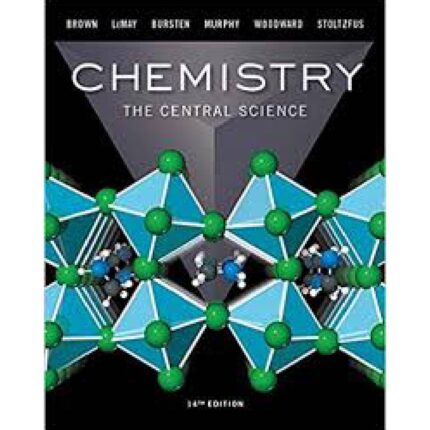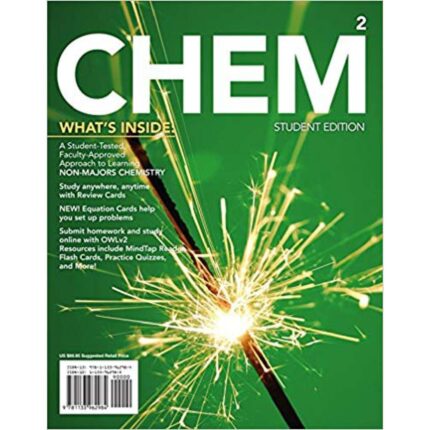Chapter 11
Intermolecular Forces and Liquids and Solids
Multiple Choice Questions
- Which one of the following substances is expected to have the highest boiling point?
A.Br2
B. Cl2
C. F2
D. I2
Bloom’s Level: 4. Analyze
Difficulty: Easy
Gradable: automatic
Section: 11.02
Subtopic: Phase Changes
Subtopic: Types of Intermolecular Forces
Topic: Intermolecular Forces
- Which one of the following substances is expected to have the lowest melting point?
A.BrI
B. CsI
C. LiI
D. NaI
E. RbI
Bloom’s Level: 4. Analyze
Difficulty: Easy
Gradable: automatic
Section: 11.02
Subtopic: Phase Changes
Subtopic: Types of Intermolecular Forces
Topic: Intermolecular Forces
- Which one of the following substances is expected to have the highest boiling point?
A.HBr
B. HCl
C. HF
D. HI
Bloom’s Level: 4. Analyze
Difficulty: Easy
Gradable: automatic
Section: 11.02
Subtopic: Phase Changes
Subtopic: Types of Intermolecular Forces
Topic: Intermolecular Forces
- Which one of the following substances is expected to have the highest melting point?
A.CH4
B. CCl4
C. CO
D. CO2
E. C(diamond)
Bloom’s Level: 4. Analyze
Difficulty: Easy
Gradable: automatic
Section: 11.06
Subtopic: Phase Changes
Subtopic: Types of Intermolecular Forces
Topic: Intermolecular Forces
- Which one of the following substances will have both dispersion forces and dipole-dipole forces?
A.HCl
B. BCl3
C. Br2
D. H2
E. CO2
Bloom’s Level: 4. Analyze
Difficulty: Medium
Gradable: automatic
Section: 11.02
Subtopic: Types of Intermolecular Forces
Topic: Intermolecular Forces
- Which one of the following substances should exhibit hydrogen bonding in the liquid state?
A.PH3
B. H2
C. H2S
D. CH4
E. NH3
Bloom’s Level: 4. Analyze
Difficulty: Medium
Gradable: automatic
Section: 11.02
Subtopic: Types of Intermolecular Forces
Topic: Intermolecular Forces
Which two properties are more typical of molecular compounds than of ionic compounds?
1. They are gases or liquids at room temperature.
2. They have high melting points.
3. Solids do not conduct electricity, but liquids do.
4. Atoms share electrons.
- 1 and 4
B. 1 and 3
C. 2 and 3
D. 2 and 4
E. 3 and 4
Bloom’s Level: 4. Analyze
Difficulty: Medium
Gradable: automatic
Section: 11.06
Subtopic: Types of Intermolecular Forces
Topic: Intermolecular Forces
- Arrange the following substances in order of increasing boiling point: CH3OH, He, CH3Cl, and N2
A. CH3OH < He < CH3Cl < N2
B. He < N2 < CH3OH < CH3Cl
C. N2 < He < CH3OH < CH3Cl
D. He < N2 < CH3Cl < CH3OH
E. CH3Cl < He < N2 < CH3OH
Bloom’s Level: 4. Analyze
Difficulty: Medium
Gradable: automatic
Section: 11.02
Subtopic: Phase Changes
Subtopic: Types of Intermolecular Forces
Topic: Intermolecular Forces
- Arrange the following substances in order of increasing boiling point: CH3CH2OH, HOCH2CH2OH, CH3CH2Cl, and ClCH2CH2OH
A.CH3CH2OH < HOCH2CH2OH < CH3CH2Cl < ClCH2CH2OH
B. CH3CH2Cl < CH3CH2OH < ClCH2CH2OH < HOCH2CH2OH
C. CH3CH2OH < CH3CH2Cl < HOCH2CH2OH < ClCH2CH2OH
D. CH3CH2Cl < ClCH2CH2OH < CH3CH2OH < HOCH2CH2OH
E. CH3CH2OH < ClCH2CH2OH < CH3CH2Cl < HOCH2CH2OH
Bloom’s Level: 5 Evaluate
Difficulty: Medium
Gradable: automatic
Section: 11.02
Subtopic: Phase Changes
Subtopic: Types of Intermolecular Forces
Topic: Intermolecular Forces
- Which of the following liquids would have the highest viscosity at 25°C?
A.CH3OCH3
B. CH2Cl2
C. C2H5OH
D. CH3Br
E. HOCH2CH2OH
Bloom’s Level: 4. Analyze
Difficulty: Medium
Gradable: automatic
Section: 11.03
Subtopic: Properties of Liquids (Surface Tension, Viscosity, Capillarity)
Subtopic: Types of Intermolecular Forces
Topic: Intermolecular Forces












Reviews
There are no reviews yet.